1902 Encyclopedia > Sewing Machines
Sewing Machines
SEWING MACHINES. The sewing machine, as is the case with most mechanical inventions, is the result of the efforts of many ingenious persons, although it would appear that the most meritorious of these worked in entire ignorance of the labours and successes of others in the same field. Many of the early attempts to sew by machinery went on the lines of imitating ordinary hand-sewing, and all such inventions proved conspicuous failures. The method of hand-sewing is of necessity slow and intermittent, seeing that only a definite length of thread is used, which passes its full extent through the cloth at every stitch, thus causing the working arm, human or otherwise, to travel a great length for every stitch made, and demanding frequent renewals of thread. The foundation of machine-sewing was laid by the invention of a double-pointed needle, with the eye in the centre, patented by Charles F. Weisenthal in 1755. This device was intended to obviate the necessity for inverting the needle in sewing or embroidering, and it was subsequently utilized in Heilman’s well-known embroidery machine.
Many of the features of the sewing machine are distinctly specified in a patent secured in England by Thomas Saint in 1790, in which he, inter alia, describes a machine for stitching, quilting, or sewing. Saint's machine, which appears to have been intended principally for leather work, was fitted with an awl which, working vertically, pierced a hole for the thread. A spindle and projection laid the thread over this hole, and a descending forked needle pressed a loop of thread through it. The loop was caught on the under side by a reciprocating hook, a feed moved the work forward the extent of one stitch and a second loop was formed by the same motions as the first. It, however, descended within the first, which was thrown off by the hook as it caught the second, and being, thus and tightened up an ordinary tambour or chain stitch was formed. Had Saint hit on the idea of the eye-pointed needle his machine would have been a complete anticipation of the modern chain-stitch machine.
The inventor who first devised a real working machine was a poor tailor, Barthélemy Thimonier, of St Etienne, who obtained letters patent in France in 1830. In Thimonier’s apparatus the needle was crocheted, and descending through the cloth it brought up with it a loop of thread which it carried through the previously made loop, and thus it formed a chain on the upper surface of the fabric. The machine was a rather clumsy affair, made principally of wood, notwithstanding which as many as eighty were being worked in Paris in 1841, making army clothing, when an ignorant and furious crowd wrecked the establishment and nearly murdered the unfortunate inventor. Thimonier, however, was not discouraged, for in 1845 he twice patented improvements on it, and in 1848 he obtained both in France and the United Kingdom patents for further improvements. The machine, was then made entirely of metal, and vastly improved on the first model. But the troubles of 1848 blasted the prospects of the resolute inventor. His patent rights for Great Britain were sold; a machine shown in the Great Exhibition of 1851 attracted no attention, and Thimonier died in 1857 unfriended and unrewarded.
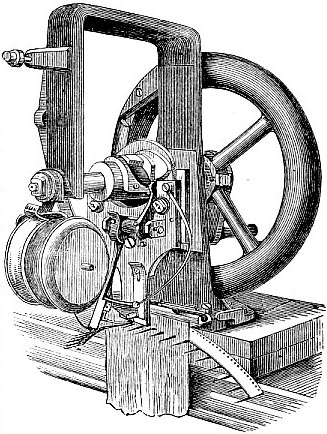
Fig. 1. Howe's original Machine.
The most important ideas of an eye-pointed needle and a double thread or lock-stitch are strictly of American origin, and that combination was first conceived by Walter Hunt of New York about 1832-34. Hunt reaped nothing of the enormous pecuniary reward which has been shared among the introducers of the sewing machine, and it is therefore all the more necessary that his great merit as an inventor should be insisted on. He constructed a machine having a vibrating arm, at the extremity of which he fixed a curved needle with an eye near its point, By this needle a loop of thread was formed under the cloth to be sewn, and through that loop a thread carried in an oscillating shuttle was passed, thus making the lock-stitch of all ordinary two-thread machines. Hunt’s invention was purchased by a blacksmith named Arrowsmith, and a good deal was done towards improving its mechanical details, but no patent was sought, nor was any serious attempt made to draw attention to the invention. After the success of machines based on his two devices was fully established, Hunt in 1853 applied for a patent; but his claim was disallowed on the ground of abandonment. The most important feature in Hunt's invention -- the eye-pointed needle -- was first patented in the United Kingdom by Newton and Archbold in 1841, in connexion with glove-stitching.
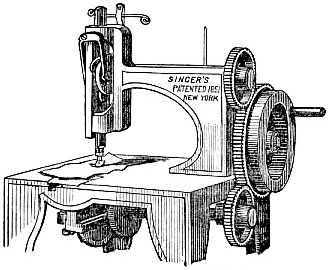
Fig. 2. Singer's original Machine.
Apparently quite unconscious of the invention of Hunt, the attention of Elias Howe, a native of Spencer, Mass., was directed to machine-sewing about year 1843. In 1844 he completed a rough model, and in 1846 he patented his sewing machine (fig. 1). Howe was thus the first to patent a lock-stitch machine, but his invention had the two essential features -- the curved eye-pointed needle and the under-thread shuttle -- which undoubtedly were invented by Walter Hunt twelve years previously. Howe's invention was sold in England to William Thomas of Cheapside, London, a corset manufacturer, for £250. Thomas secured in December 1846 the English patent in his own name, and engaged Howe on weekly wages to adapt the machine for his manufacturing purposes. The career of the inventor in London was chequered and unsuccessful and, having pawned his American patent rights in England, he returned in April 1849 in deep poverty to America. There in the meantime the sewing machine was beginning to excite public curiosity, and various persons were making machines which Howe found to trench on his patent rights. The most prominent of the manufacturers, if not of inventors, ultimately appeared in the person of Isaac Merritt Singer, who in 1851 secured a patent for his machine (fig. 2), and immediately devoted himself with immense energy to push the fortunes of the infant industry. Howe now became alert to vindicate his rights, and, after regaining possession of his pawned patent, he instituted suits against the infringers. An enormous amount of litigation ensued, in which Singer figured as a most obstinate defendant, but ultimately all makers became tributary to Elias Howe. It is calculated that Howe received in the form of royalties on machines made up to the period of the expiry of his extended patent -- September 1867 -- which was also the month of his death, a sum of not less than two millions of dollars.
The practicability of machine-sewing being demonstrated, inventions of considerable originality and merit followed in quick succession. One of the most ingenious of all the inventors -- who worked also without knowledge of previous efforts -- was Mr Allan B. Wilson. In 1849 he devised the rotary hook and bobbin combination, which now forms the special feature of the Wheeler & Wilson machine. Mr Wilson obtained a patent for his machine which included the important and effective four-motion feed, in November 1850. In February 1851 Mr William O. Grover, tailor, of Boston, patented his double chain-stitch action, which formed the basis of the Grover & Baker machine. At a later date, in 1856, Mr James A. E. Gibbs, a Virginia farmer, devised the improved chain-stitch machine now popularly known as the Willcox & Gibbs. These together -- all American inventions -- form the types of the various machines now in common use. Several thousands of patents have been issued in the United States and Europe, covering improvements in the sewing machine; but, although the efficiency of the machine has been greatly increased by numerous accessories and attachments, the main principles of the various machines have not been affected thereby.
In machine sewing there are three varieties of stitch made -- (1) the simple chain or tambour stitch, (2) the double chain stitch, and (3) the lock stitch. In the first variety the machine works with a single thread; the other forms use two, an upper and an under thread.
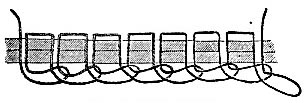
Fig. 3. Chain Stitch.
The structure of the chain stitch is shown in fig. 3. The needle first descends through the cloth, then as it begins to ascend the friction of the thread against the fabric is sufficient to form a small loop into which the point of a hook operating under the cloth plate enters, expanding and holding tho loop while the needle rises to its full height. The feed then moves the fabric forward one stitch length, the hook with its loop is also projected so that when next the needle descends its loop is formed within the previous loop. The hook then releases loop No. 1, seizes and expands loop No. 2, and in so doing draws up the previous loop into a stitch, chain-like on the under side but plain on the upper surface of the fabric. The seam so made is firm and elastic, but easily undone, for if at any point a thread is broken the whole of the sewing can be readily run out backwards by pulling the thread, just as in crochet work. To a certain extent this imperfection in the chain-stitch machine is overcome in the Willcox & Gibbs machine, in which each loop is, by means of a rotating hook, twisted half a revolution after it has passed through its predecessor.
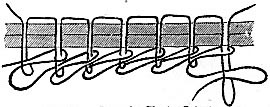
Fig. 4. Double Chain Stitch.
The double chain stitch is made by machines associated with the name of Grover & Baker. The somewhat complicated course of the threads in this stitch is shown in fig. 4. The under thread in this machine is supplied from an ordinary bobbin and is threaded through a circular needle of peculiar form. The machine is wasteful of thread, and the sewing forms a knotted ridge on the under side of the fabric. Except for special manufacturing and ornamental purposes the machine is now in little use.

Fig. 5. Lock Stitch.
The lock stitch is that made by all ordinary two-thread sewing machines, and is a stitch peculiar to machine sewing. Its structure is, as shown in fig. 5, very simple, and when by proper tension the threads in terlock within the work the stitch shows the same on both sides and is very secure. When, however, the tension on the upper thread is weak, the under thread runs along the surface as at b, held more or less tightly by the upper loops. It will be seen that to make the chain stitch the under thread has to be passed quite through the loop of the upper thread. That is done in two principal ways, By the first plan a small metal shuttle, holding within it a bobbin of thread, is carried backward and forward under the cloth plate, and at each forward movement it passes through the upper thread loop formed by each succeeding stroke of the needle. Such is the principle devised by Hunt, introduced by Howe, and improved by Singer and many others. The second principal method of forming the lock stitch consists in seizing the loop of the upper thread by a rotating hook, expanding the loop and passing it around a stationary bobbin within which is wound the under thread. The method is the invention of Mr A. B. Wilson, and is known generally as the Wheeler & Wilson principle. The rotary hook seen at b, fig. 6, is so bevelled and notched that it opens and expands the upper thread loop, causing it quite to enclose the bobbin of under thread, after which it throws it off and the so-formed lock stitch is pulled up and tightened either by an independent take-up motion as in recent machines, or by the expansion of the next loop as in the older forms. The bobbin A, lenticular in form, and its case B, fig. 6, fit easily into a circular depression xithin the hook, against wbich they are held by the bobbin holder a, fig. 6.
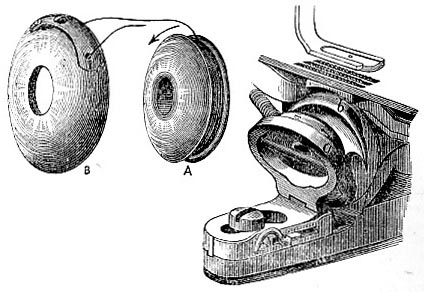
Fig. 6. Rotary Hook, Bobbin, and Bobbin Case (Wheeler & Wilson Machine)
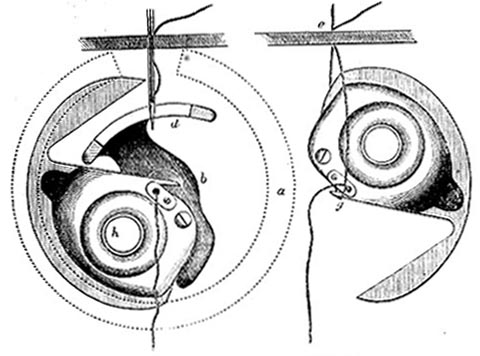
Fig. 7. Singer's Oscillating-Shuttle Machine.
Intermediate between the shuttle and the rotary-hook machines is the new oscillating-sbuttle machine introduced by the Singer Co. The shuttle is hook-formed, not unlike the Wilson hook, and it carries within it a capacious circular bobbin of thread h, fig. 7. This shuttle is driven by an oscillating driver db within an annular raceway a a, and, instead of revolving completely like the Wilson hook, it only oscillates in an arc of 150°, so far as to catch and clear the upper thread. The oscillating shuttle and rotary-hook machines work with great smoothness and rapidity.
There are numerous special sewing, machines adapted for leather work, glove-sewing, &c., some of which will be alluded to under SHOES. (J. PA.)
Share this page:
The above article was written by James Paton, F.L.S.; Superintendent of Museums and Art Galleries of Corporation of Glasgow from 1876; Assistant in Museum of Science and Art, Edinburgh, 1861-76; President of Museums Association of the United Kingdom, 1896; editor and part-author of Scottish National Memorials, fol. 1890.
|






